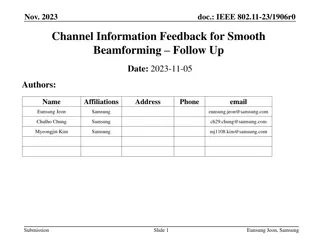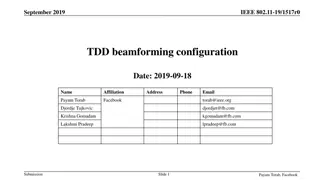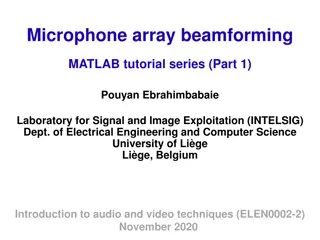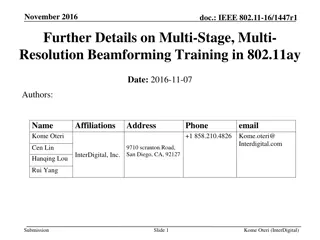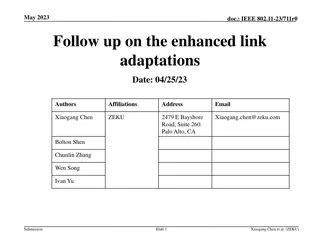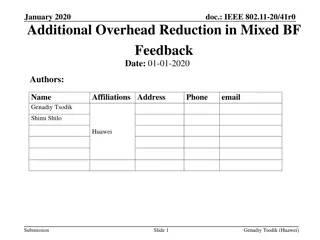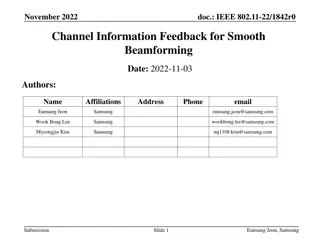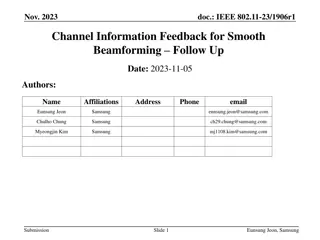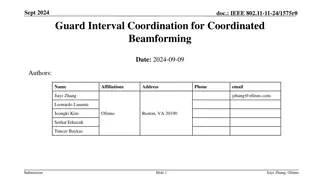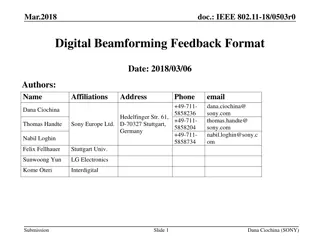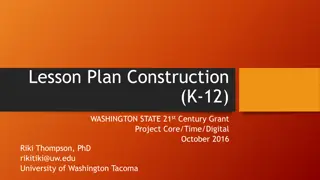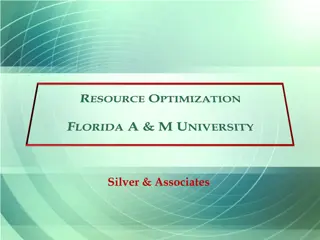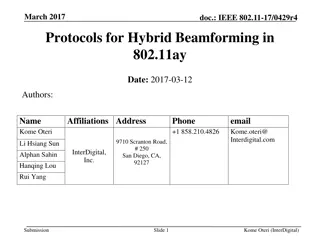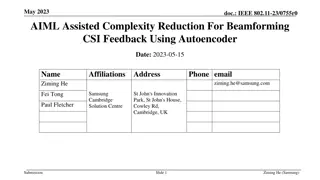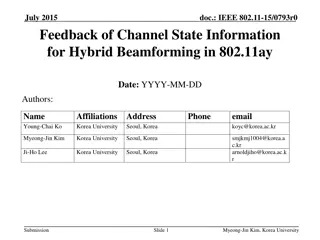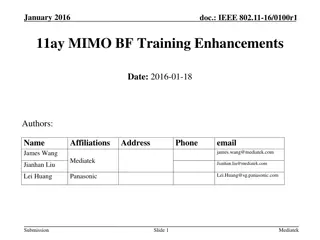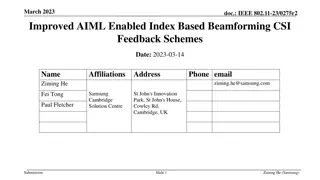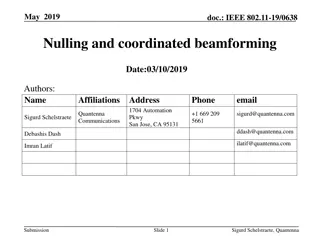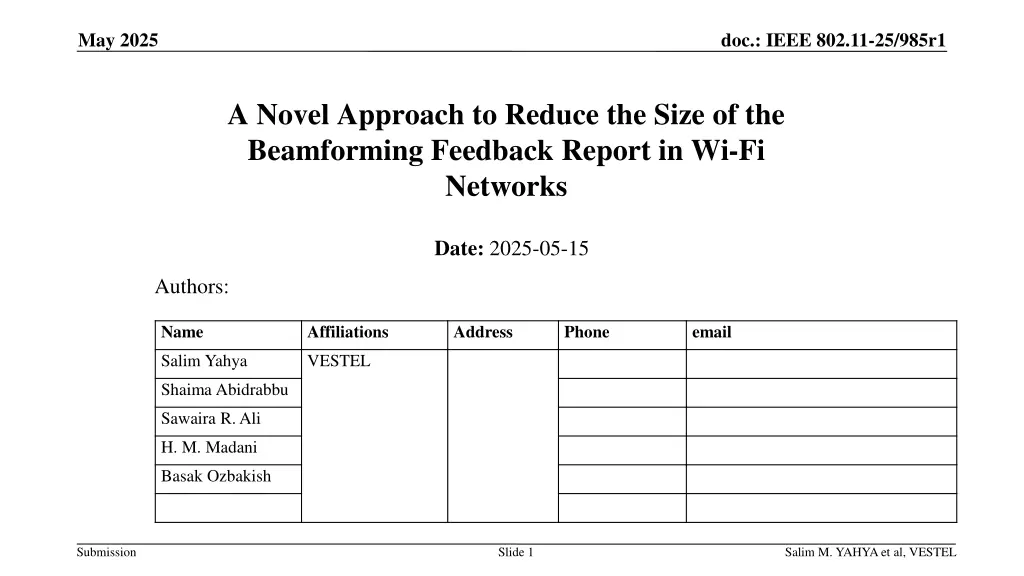
Reducing Beamforming Feedback Size in Wi-Fi Networks
Explore a novel approach to minimize the size of beamforming feedback reports in Wi-Fi networks, focusing on UL beamforming in MU-MIMO operations. The discussion includes issues with per-STA precoding, joint precoding, and a proposed Triggered Grouped Beamforming Report (G-BFR) method. Discover how APs send triggering frames to STAs and use NDPs to estimate beamforming reports for efficient beamformed uplink data transmission.
Download Presentation

Please find below an Image/Link to download the presentation.
The content on the website is provided AS IS for your information and personal use only. It may not be sold, licensed, or shared on other websites without obtaining consent from the author. If you encounter any issues during the download, it is possible that the publisher has removed the file from their server.
You are allowed to download the files provided on this website for personal or commercial use, subject to the condition that they are used lawfully. All files are the property of their respective owners.
The content on the website is provided AS IS for your information and personal use only. It may not be sold, licensed, or shared on other websites without obtaining consent from the author.
E N D
Presentation Transcript
May 2025 doc.: IEEE 802.11-25/985r1 A Novel Approach to Reduce the Size of the Beamforming Feedback Report in Wi-Fi Networks Date: 2025-05-15 Authors: Name Affiliations Address Phone email Salim Yahya VESTEL Shaima Abidrabbu Sawaira R. Ali H. M. Madani Basak Ozbakish Submission Slide 1 Salim M. YAHYA et al, VESTEL
May 2025 doc.: IEEE 802.11-25/985r1 Introduction Support for beamforming in TB PPDUs has been discussed in 11be (WiFi 7) [1] as well as during the UHR (WiFi 8) SG [2-4]. [5] summarized the benefits of supporting BF for TB PPDUs, and then ran a SP for defining a protocol for supporting triggered UL beamformed data transmission in TGbn The results were 105Y, 71N [6] discussed non-triggered per-STA precoding, its performance compared with triggered (joint) precoding and the reason for the performance gap. [1],[2] and [3] have insisted the benefits of UL TB in MU-MIMO although standard is yet to accommodate it. Submission Slide 2 Salim M. YAHYA et al, VESTEL
May 2025 doc.: IEEE 802.11-25/985r1 UL BF in MU-MIMO operation (TB PPDU) cont. As discussed in the contributions, AP sends Triggering frame to the STA's and the STA's respond with NDP's which are used by the AP to estimate Beamfroming Report The solicited STAs use the precoding values to respond with Beamformed Uplink data HE TB PPDUs Submission Slide 3 Salim M. YAHYA et al, VESTEL
May 2025 doc.: IEEE 802.11-25/985r1 Issues with Per-STA Precoding, joint precoding In the case of SU-MIMO, precoders computed separately per-STA are generally good Issue #1 Adding individual request from each non-AP STA to start UL sounding procedure seems inefficient (compared to a unified, AP managed and efficient protocol). Partially Solved by Joint precoding Issue #2 relates to the MU-MIMO case, in particular, the usage of per-STA precoding rather than Joint precoding , which is computed by the AP for all the solicited non-AP STAs Using the per-STA precoding gives little to no gain over open-loop transmissions (doesn t decrease the MUI), as opposed to using a joint precoder computed at the AP which yields a huge gap Issue #3 Using joint pre-coding can unnecessarily increase overhead for users who are in different directions of the AP Submission Slide 4 Salim M. YAHYA et al, VESTEL
May 2025 doc.: IEEE 802.11-25/985r1 Proposed Triggered Grouped Beamforming Report (G-BFR) First the AP sends Sounding Trigger Frame to all STA's soliciting their NDP s. The STA's: o With BF capability send the NDP's to AP. o Without BF capability will not respond to the TF The AP : o Uses the NDP's to determine Beamforming Report (BFR) precoding matrix for responding STA's. o Needs to determine the beamwidth and directions based on STA's that responded to the NDP o Since it can determine the side on which the STA's are located, it will BF the precoding matrices in groups. The STA's can then use the precoding matrices to do BF. Submission Slide 5 Salim M. YAHYA et al, VESTEL
May 2025 May 2025 doc.: IEEE 802.11-25/985r1 Proposed Grouped BFR-1 Beamforming Feedback Reports sent Groupwise based on spatial separation Instead of a matrix containing all the STA s, each group receives a precoding matrix based on the group s constituent STA s Smaller matrix size Less computation complexity for STA s MUI can be handled Less per STA overhead Submission Slide 6 Salim M. YAHYA et al, VESTEL
May 2025 doc.: IEEE 802.11-25/985r1 Proposed Groped BFR 2 - Sectoring For less dynamic scenarios, like in workplaces, where users are already grouped, Sectoring can be applied to reduce implementation complexity. This sectoring doesn t have to be symmetric e.g., instead of always being 3 x 120 , it could be 60 , 80 100 depending on requirements. Validity duration can be determined to update the precoding matrices for the corresponding directions Submission Slide 7 Salim M. YAHYA et al, VESTEL
May 2025 doc.: IEEE 802.11-25/985r1 Other Features of Proposed Approach Due to separate beams between groups, secrecy is improved. Between different groups Between group and non-group members Beam width, and direction are also to be considered when constructing the feedback matrix. Resources can be re-used further increasing spectral efficiency SE. Submission Slide 8 Salim M. YAHYA et al, VESTEL
May 2025 doc.: IEEE 802.11-25/985r1 Advantages of the Proposed Approach 1.The proposed approach: o is not like the use of the SU-MIMO approach where the per-STA precoding feedback is sent individually. o Also, it is not like the joint precoding that is used in MU-MIMO where the whole feedback is sent to all users with huge size. o Utilizes the spatial space to send coordinated feedback based on the users' directions. As if it is in between the afore-mentioned approaches. 2.Such an approach is compatible with Wi-Fi and it can solve a legitimate problem for UL-MU-MIMO when it comes to the size of the BFR. 3.The proposed solution is not discussed yet in the standard meetings. Submission Slide 9 Salim M. YAHYA et al, VESTEL
May 2025 doc.: IEEE 802.11-25/985r1 Conclusions Beamforming is an important feature of 802.11, and is widely used in products, in both DL & UL. Since 11ax, triggered transmissions (TB PPDUs) are commonly used in the UL. There have been discussions on how to send estimated precoding matrices to STA's Per STA which is considered inefficient Joint precoding which sends unnecessarily huge matrices to STA's, wasting bandwidth We propose grouped pre-coding where the precoding matrices are grouped based on spatial distribution of STA's Submission Slide 10 Salim M. YAHYA et al, VESTEL
May 2025 doc.: IEEE 802.11-25/985r1 Straw Poll Do you agree to add the following statement to the standards?: A Grouped Beamforming Feedback Matrix shall be utilized to reduce overhead for STAs and to lower computation complexity associated with the received Feedback Matrix Yes No Abstain or More Discussion needed Submission Slide 11 Salim M. YAHYA et al, VESTEL
May 2025 doc.: IEEE 802.11-25/985r1 References [1] 11-20-1672r2: UL Beamforming for TB PPDUs (Shimi Shilo et al) [2] 11-23-27r1: Uplink MU-MIMO Improvements (Sigurd Schelstraete et al) [3] 11-23-725r0: Uplink MU-MIMO Precoding Follow Up (Sigurd Schelstraete et al) [4] 11-23-263r0: Triggered Beamforming in UHR (Shimi Shilo et al) [5] 11-24-108r0: Triggered Beamforming in UHR Follow Up (Shimi Shilo et al) Submission Slide 12 Salim M. YAHYA et al, VESTEL

